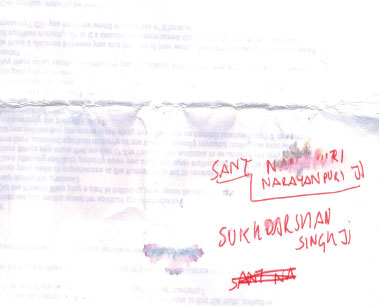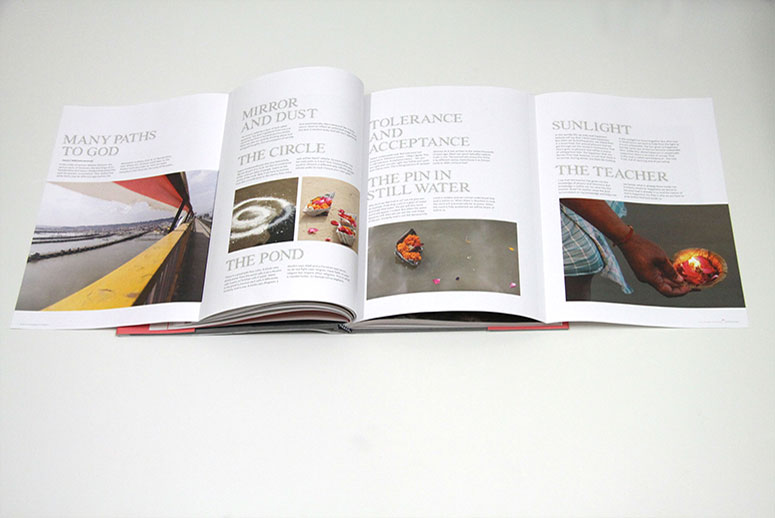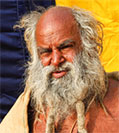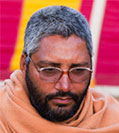- Voices in the book
- Preface
- Maps and Navigation
- Vol 1: Place, Time, Astronomy
- Vol 2: History, Mythology, Belief
- Vol 3: Ganga, Yamuna, Saraswati
- Vol 4: Seva, Sadhana, Satsang
- Vol 5: Guru, Disciple, University
- Vol 6: Abstinence, Penance, Charity
- Vol 7: Faith, Fate, Worship
- Vol 8: Services, Sellers, Spectacle
Vol 5: Guru, Disciple, University
What does one learn at the Kumbh Mela? Religion, rituals, reasoning and responsiveness to what is within. The guru-shishya custom forms the basis of many a tradition.
Guru, Disciple, University speaks of this custom in and around the Kumbh. Gurus at the Kumbh take different forms with unique beliefs. All in pursuit of the same end. The Sangam, where the waters of the Ganga and Yamuna unite with the mystical river Saraswati, the Goddess of knowledge, is a befitting backdrop for learning the lessons of life. The Divine is discovered and delved into deeper with the aid of the wise and sagacious. A humanitarian, a Kumbh veteran, a student of political science and a proponent of the Ramakrishna Mission are just some of the attendees sharing their views, which range from the likeness between a mother and her infant and a guru and his disciple, how human behaviour mirrors biological relationships and the many paths to God.
Contents of Guru, Disciple, University
 We were opposites at intersections (Poetic Verse)
We were opposites at intersections (Poetic Verse) Muni Baba (Insight)
Muni Baba (Insight) Guru, Disciple, University (Introduction)
Guru, Disciple, University (Introduction) Bansri Baba (Insight)
Bansri Baba (Insight) Marked by God (Photo Story)
Marked by God (Photo Story) Sant Avmuktanandji (Insight)
Sant Avmuktanandji (Insight) Bansri Baba (Insight)
Bansri Baba (Insight) Swami Hansdevacharyaji Maharaj (Interview)
Swami Hansdevacharyaji Maharaj (Interview) Sadhvi Bhagwati Saraswatiji (Insight)
Sadhvi Bhagwati Saraswatiji (Insight)
 Sant Avmuktanandji (Insight)
Sant Avmuktanandji (Insight) Being, not becoming (Character Story)
Being, not becoming (Character Story) Sant Avmuktanandji (Insight)
Sant Avmuktanandji (Insight) Soltitude, Multitude (Reflection)
Soltitude, Multitude (Reflection) Kalyandasji Maharaj (Insight)
Kalyandasji Maharaj (Insight) 10.01.2013 (Diary Notes)
10.01.2013 (Diary Notes) Nirbhayadas Kothariji (Insight)
Nirbhayadas Kothariji (Insight) 13.02.2013 (Diary Notes)
13.02.2013 (Diary Notes)
Excerpts From The Book: bansri baba (insight)


Excerpts From The Book: 13.02.2013 (Diary Note)

In response to our questions, Mauni Baba drew monosyllabic replies in the sand. Now a revered saint, he had taken the vow of silence 30 years ago. He sat before us, smiling and peaceful in a state of obvious enlightenment. Graciously interpreting Mauni Baba’s writings for us was one from a bunch of his disciples that sat around. This saffron-clad man, a saint himself, allowed us the privilege of interviewing him. As we walked together through the camp, a turbaned man suddenly shot up to his feet on seeing the saint with us, bowing respectfully before him. From this, it seemed clear that the camp followed a hierarchical system.
Mauni Baba was to the saffron-clad saint what the saffron-clad saint was to the man with the turban. The reverence shown for the higher saint and gracious dealings with the devotees sustains a delicate harmony within the camp. The man wearing the turban evidently constituted another level within the hierarchy and eager to get to know more, I rushed over to where he stood. ‘My name is Sukhdarshan Singhji’, he replied and I jotted it down on the piece of paper I had with me at the time. It was important that we had the names and as much background information on all the people we spoke with at the Mela. I also asked for the name of the saffron-clad saint before whom he just bowed. He replied and as I put pen to paper to write the name just below his own, I was startled by a loud, ‘Arre!’ Sukhdarshanji looked at me disapprovingly and questioned how I could write Sant Narayan Puriji, the name of the saffron-clad saint, below his.
He assumed that I should have known that it is only respectful and appropriate to write a devotee’s name under the saint’s and not above.





